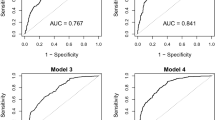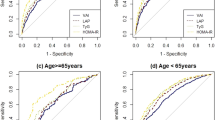Abstract
Objective:
To compare the ability of biochemical indices of insulin resistance (IR) with metabolic syndrome (MetS) classifications to predict changes in blood glucose control over a 3-year period in overweight and obese subjects.
Design:
This was a longitudinal, prospective study, with data collected at baseline, 18 and 36 months.
Subjects and methods:
A total of 175 overweight (body mass index (BMI)>25 kg m−2) and obese (BMI>30 kg m−2) subjects were enrolled in the study. The IR indices assessed included fasting insulin concentration, the insulin/glucose-derived indices, homeostasis assessment model of insulin resistance (HOMA-IR) and quantitative insulin sensitivity check index (QUICKI), the insulin/triglyceride-derived McAuley index, plasma adiponectin concentration and the triglyceride (trig) and high-density lipoprotein (HDL)-cholesterol ratio (trig:HDL). The two MetS classifications were assessed according to the definitions of the National Cholesterol Education Program–Third Adult Treatment Panel (NCEP-ATPIII) and the International Diabetes Federation (IDF). The potential of the IR indices and MetS classifications at baseline to predict the development of impaired fasting glucose (IFG) was examined using receiver-operator characteristic (ROC) curve analysis and analysis of variance.
Results:
Complete data were collected on 158 subjects. In all, 51 (32%) subjects developed IFG during the study. The analysis of variance showed significant differences between the IFG and normoglycaemic group in the baseline values of the McAuley index, trig:HDL, plasma adiponectin concentration and prevalence of the MetS. The ROC curve analysis confirmed this result and showed that the strongest predictors of IFG were baseline trig:HDL and IDF MetS classification, followed in order by the McAuley index, plasma adiponectin concentration and NCEP-ATPIII MetS classification. In contrast, the baseline values of fasting insulin, HOMA-IR and QUICKI did not predict IFG.
Discussion:
This study showed that the IR indices, derived, in part, from plasma triglyceride concentration, were sensitive predictors for the development of IFG in normoglycaemic overweight and obese subjects. Indices derived from glucose and insulin did not identify this at-risk group. The study also showed that the presence of MetS and its abnormalities of an increased trig:HDL ratio and low plasma adiponectin concentration were all sensitive predictors of IFG.
This is a preview of subscription content, access via your institution
Access options
Subscribe to this journal
Receive 12 print issues and online access
$259.00 per year
only $21.58 per issue
Buy this article
- Purchase on Springer Link
- Instant access to full article PDF
Prices may be subject to local taxes which are calculated during checkout
Similar content being viewed by others
References
Ferrannini E . Insulin resistance versus insulin deficiency in non-insulin-dependent diabetes mellitus: problems and prospects. Endocr Rev 1998; 19: 477–490.
Pacini G, Mari A . Methods for clinical assessment of insulin sensitivity and β-cell function. Best Pract Res Clin Endocrinol Metab 2003; 17: 305–322.
Sainaghi PP, Castello L, Bergamasco L, Carnevale Schianca GP, Bartoli E . Metabolic characteristics of glucose intolerance: the critical role of obesity. Exp Clin Endocrinol Diab 2008; 116: 86–93.
Shoelson SE, Herrero L, Naaz A . Obesity, inflammation and insulin resistance. Gastroenterology 2007; 132: 2169–2180.
Jones CN, Abbasi F, Carantoni M, Polonsky KS, Reaven GM . Roles of insulin resistance and obesity in regulation of plasma insulin concentrations. Am J Physiol Endocrinol Metab 2000; 278: E501–E508.
DeFronzo RA, Tobin JD, Andres R . Glucose clamp technique: a method for quantifying insulin secretion and resistance. Am J Physiol 1979; 237: E214–E223.
Laakso M . How good a marker is insulin for insulin resistance? Am J Epidemiol 1993; 137: 959–965.
Legro RS, Finegood D, Dunaif A . A fasting glucose to insulin ratio is a useful measure of insulin sensitivity in women with polycystic ovary syndrome. J Clin Endocrinol Metab 1998; 83: 2694–2698.
Bergmann RN, Ider YZ, Bowden CR, Cobelli C . Quantitative estimation of insulin sensitivity. Am J Physiol Endocrinol Metab 1979; 236: E667–E677.
Katz A, Nambi SS, Mather K, Baron AD, Follmann DA, Sullivan G et al. Quantitative insulin sensitivity check index: a simple accurate method for assessing insulin sensitivity in humans. J Clin Endocrinol Metab 2000; 85: 2402–2410.
McAuley KA, Williams SM, Mann JI, Walker RJ, Lewis-Barned NJ, Temple LA et al. Diagnosing insulin resistance in the general population. Diabetes Care 2001; 24: 460–464.
Haffner SM, Valdez RA, Hazuda HP, Mitchell BD, Morales PA, Stern MP . Prospective analysis of the insulin-resistance syndrome (syndrome X). Diabetes 1992; 41: 715–722.
McLaughlin T, Abbasi F, Cheal K, Chu J, Lamendola C, Reaven G . Use of metabolic markers to identify overweight individuals who are insulin resistant. Ann Intern Med 2003; 139: 802–809.
Matsuzawa Y . Adiponectin: identification, physiology and clinical relevance in metabolic and vascular disease. Atherosclerosis Suppl 2005; 6: 7–14.
Spranger J, Kroke A, Möhlig M, Bergmann MM, Ristow M, Boeing H et al. Adiponectin and protection against type 2 diabetes. Lancet 2003; 61: 226–228.
Shand BI, Scott RS, Elder PA, George PM . Plasma adiponectin in overweight, nondiabetic individuals with or without insulin resistance. Diabetes Obes Metab 2003; 5: 349–353.
Expert Panel on Detection, Evaluation, and Treatment of High Blood Cholesterol in Adults. Executive summary of the third report of the National Cholesterol Education Program (NCEP) expert Panel on Detection, Evaluation, and Treatment of High Blood Cholesterol in Adults (Adult Treatment Panel III). JAMA 2001; 285: 2486–2497.
Zimmet PZ, Alberti KGMM, Shaw JE . Mainstreaming the metabolic syndrome: a definitive definition. Med J Aust 2005; 183: 175–176.
Alberti KG, Zimmet PZ . Definition, diagnosis and classification of diabetes mellitus and its complications. Part 1: diagnosis and classification of diabetes mellitus, provisional report of a WHO consultation. Diabetes Med 1998; 15: 539–553.
Shand B, Elder P, Scott R, Frampton C, Willis J . Biovariability of plasma adiponectin. Clin Chem Lab Med 2006; 44: 1264–1268.
Levy JC, Matthews DR, Hermans MP . Correct homeostasis model assessment evaluation uses the computer program. Diabetes Care 1998; 21: 2191–2192.
Wilson PW, Meigs JB, Sullivan L, Fox CS, Nathan DM, D’Agostino Sr RB . Prediction of incident diabetes mellitus in middle-aged adults: the Framingham Offspring Study. Arch Int Med 2007; 167: 1068–1074.
Abdul-Ghani MA, Williams K, DeFronzo RA, Stern M . What is the best predictor of future type 2 diabetes? Diabetes Care 2007; 30: 1544–1548.
Zavaroni I, Bonini L, Fantuzzi M, Dall’AglioE, Passeri M, Reaven GM . Hyperinsulinaemia, obesity, and syndrome X. J Intern Med 1994; 235: 51–56.
Hanley AJG, Karter AJ, Williams K, Festa A, D’Agostino RB, Wagenknecht LE et al. Prediction of type 2 diabetes mellitus with alternative definitions of the metabolic syndrome. The Insulin Resistance Atherosclerosis Study. Circulation 2005; 112: 3713–3721.
Lorenzo C, Williams K, Hunt KJ, Haffner SM . The National Cholesterol Education Program—Adult Treatment Panel III, International Diabetes Federation, and World Health Organization definitions of the metabolic syndrome as predictors of incident cardiovascular disease and diabetes. Diabetes Care 2007; 30: 8–13.
Whitehead JP, Richards AA, Hickman IJ, Macdonald GA, Prins JB . Adiponectin—a key adipokine in the metabolic syndrome. Diabetes Obes Metab 2006; 8: 264–280.
Bovet P, Faeh D, Gabriel A, Tappy L . The prediction of insulin resistance with serum triglyceride and high-density lipoprotein cholesterol in an East African population. Arch Intern Med 2006; 166: 1236–1237.
Hannon TS, Bacha F, Lee SJ, Janosky J, Arslanian SA . Use of markers of dyslipidemia to identify overweight youth with insulin resistance. Pediatr Diabetes 2006; 7: 260–266.
Maruyama C, Imamura K, Teramoto T . Assessment of LDL particle size by triglyceride/HDL-cholesterol ratio in nondiabetic, healthy subjects without prominent hyperlipidemia. J Atheroscler Thromb 2003; 10: 186–191.
Waki H, Yamauchi T, Kamon J, Ito Y, Uchida S, Kita S et al. Impaired multimerization of human adiponectin mutants associated with diabetes. Molecular structure and multimer formation of adiponectin. J Biol Chem 2003; 278: 40352–40363.
Acknowledgements
This study was funded by a grant from the Heart Foundation of New Zealand, Eli Lilly New Zealand Diabetes Research Grant and Novo Nordisk New Zealand Diabetes Research Grant. We are grateful to Dr Jinny Willis, Maree Piebenga, Alice Johnstone and Victoria Halliday for carrying out the clinical measurements and blood sample collections during the study, and to Dr Claude Andre for helpful discussions during preparation of the article.
Author information
Authors and Affiliations
Corresponding author
Rights and permissions
About this article
Cite this article
Shand, B., Scott, R., Lewis, J. et al. Comparison of indices of insulin resistance with metabolic syndrome classifications to predict the development of impaired fasting glucose in overweight and obese subjects: a 3-year prospective study. Int J Obes 33, 1274–1279 (2009). https://doi.org/10.1038/ijo.2009.169
Received:
Revised:
Accepted:
Published:
Issue Date:
DOI: https://doi.org/10.1038/ijo.2009.169
Keywords
This article is cited by
-
Black chokeberry Aronia melanocarpa extract reduces blood pressure, glycemia and lipid profile in patients with metabolic syndrome: a prospective controlled trial
Molecular and Cellular Biochemistry (2021)
-
Evaluation of surrogate markers for insulin resistance for defining metabolic syndrome in urban Indian adolescents
Indian Pediatrics (2014)



